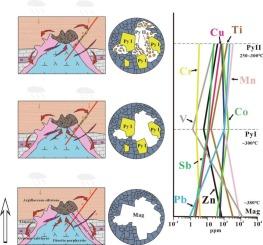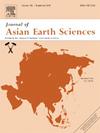Ore genesis of the Baimashan Fe-S crypto-explosive breccia deposit in Fanchang volcanic basin, eastern China: insights into the ultra-shallow intrusive metallogenesis
IF 2.4
3区 地球科学
Q2 GEOSCIENCES, MULTIDISCIPLINARY
引用次数: 0
Abstract
The Baimashan iron-sulfur polymetallic deposit exemplifies an ultra-shallow cryptoexplosive breccia-type deposit situated in the Fanchang region of the Middle-Lower Yangtze Metallogenic Belt (MLYMB) in eastern China, with its formation occurring at a depth of approximately 400 m. Analyzing its metallogenic characteristics and processes offers significant insights into the late Mesozoic ultra-shallow mineralization within the MLYMB. A thorough petrographic analysis reveals that magnetite (Mag, 0.5–1 mm) is associated with a specific metallogenic stage, while pyrite can be categorized into Py Ⅰ (early stage, 0.5–1 mm) and Py II (late stage, <0.1 mm). Laser ablation-inductively coupled plasma-mass spectrometry (LA-ICP-MS) techniques, including element point and mapping analyses, in addition to in-situ sulfur isotope analysis of pyrite, are employed to determine the genesis of the deposit and the evolution of the ore-forming hydrothermal fluid. The temporal signal diagram derived from LA-ICP-MS point analysis, element binary diagrams, and LA-ICP-MS mapping outcomes collectively demonstrate that the majority of trace elements present in both magnetite and pyrite exist as solid solution within the mineral structure. However, magnetite contains partial incorporation of Co, Ni, As, Sb, Ti, Sn, and W, while pyrite incorporates Ag, Bi, Tl, and Sb into its sulfide inclusions. Additionally, LA-ICP-MS analysis reveals that Py Ⅰ exhibits relatively higher concentrations of Co, Ni, and As, whereas Py II shows enrichment of Cu, Pb, Zn, Ag, Sb, and Tl. Notably, the Co/Ni ratios in both Py Ⅰ and Py II exhibit similar trends and temperature ranges, suggesting a shared variation in temperature during their formation. Moreover, the Co/Ni mapping image’s cross section provides a detailed depiction of the temperature fluctuations during the process of pyrite formation. The discriminant diagram provides evidence supporting the hydrothermal origin of magnetite, and all suggests that pyrite was formed in a hydrothermal environment with lower temperatures with two hydrothermal pulses. Analysis of in-situ sulfur isotopes reveals that the δ34S values of Py Ⅰ range from +3.41 ‰ to +5.54 ‰, with an average of 4.63 ‰, while Py II has δ34S values ranging from +2.47 ‰ to +4.50 ‰, with an average of 3.62 ‰. Through a comparative analysis and discussion of regional skarn-type and porphyrite-type iron ores, it is inferred that the ore-forming fluid exhibits characteristics indicative of a mixture between magmatic hydrothermal fluid and meteroic water, with minimal involvement of brine from gypsum layers. Building upon this research, this paper develops a metallogenic model for the Baimashan ultra-shallow intrusive deposit. By examining the mineralization processes of porphyrite-type iron deposits, it is suggested that too early occurrence of cryptoexplosion, resulting from ultra-shallow emplacement, is detrimental to the enrichment and mineralization of magnetite. Consequently, the appropriate emplacement depth is deemed crucial for the successful formation of such deposits.

繁昌火山盆地白马山Fe-S隐爆角砾岩矿床矿床成因:对超浅侵入成矿作用的认识
白马山铁硫多金属矿床是位于中国东部中下游扬子成矿带繁昌地区的超浅隐爆角砾岩型矿床,其形成深度约为400 m。分析其成矿特征和成矿过程对研究晚中生代超浅成矿作用具有重要意义。岩石学分析表明,磁铁矿(Mag, 0.5-1 mm)与特定的成矿阶段有关,而黄铁矿可分为PyⅠ(早期,0.5-1 mm)和Py II(晚期,<0.1 mm)。采用激光烧蚀-电感耦合等离子体质谱(LA-ICP-MS)技术,结合元素点图分析和原位硫铁矿硫同位素分析,确定矿床成因和成矿热液演化。由LA-ICP-MS点分析得到的时间信号图、元素二元图和LA-ICP-MS作图结果共同表明,在磁铁矿和黄铁矿中存在的大部分微量元素以固溶体形式存在于矿物结构中。然而,磁铁矿含有Co、Ni、As、Sb、Ti、Sn和W,而黄铁矿的硫化物包裹体中含有Ag、Bi、Tl和Sb。此外,LA-ICP-MS分析显示,PyⅠ中Co、Ni和As的浓度相对较高,而Py II中Cu、Pb、Zn、Ag、Sb和Tl的浓度相对较高。值得注意的是,PyⅠ和Py II中Co/Ni的比值表现出相似的趋势和温度范围,表明它们在形成过程中有共同的温度变化。此外,Co/Ni映射图像的横截面提供了黄铁矿形成过程中温度波动的详细描述。判别图提供了磁铁矿热液成因的证据,表明黄铁矿形成于温度较低的热液环境中,形成于两个热液脉冲。原位硫同位素分析表明,PyⅠ的δ34S值在+3.41‰~ +5.54‰之间,平均为4.63‰;Py II的δ34S值在+2.47‰~ +4.50‰之间,平均为3.62‰。通过对区域矽卡岩型和斑岩型铁矿的对比分析和讨论,认为成矿流体表现为岩浆热液与气象水的混合,石膏层卤水的参与最小。在此基础上,建立了白马山超浅侵入矿床成矿模式。通过对斑岩型铁矿成矿过程的考察,认为超浅侵位导致隐爆过早发生不利于磁铁矿的富集成矿。因此,适当的就位深度被认为是成功形成这种矿床的关键。
本文章由计算机程序翻译,如有差异,请以英文原文为准。
求助全文
约1分钟内获得全文
求助全文
来源期刊

Journal of Asian Earth Sciences
地学-地球科学综合
CiteScore
5.90
自引率
10.00%
发文量
324
审稿时长
71 days
期刊介绍:
Journal of Asian Earth Sciences has an open access mirror journal Journal of Asian Earth Sciences: X, sharing the same aims and scope, editorial team, submission system and rigorous peer review.
The Journal of Asian Earth Sciences is an international interdisciplinary journal devoted to all aspects of research related to the solid Earth Sciences of Asia. The Journal publishes high quality, peer-reviewed scientific papers on the regional geology, tectonics, geochemistry and geophysics of Asia. It will be devoted primarily to research papers but short communications relating to new developments of broad interest, reviews and book reviews will also be included. Papers must have international appeal and should present work of more than local significance.
The scope includes deep processes of the Asian continent and its adjacent oceans; seismology and earthquakes; orogeny, magmatism, metamorphism and volcanism; growth, deformation and destruction of the Asian crust; crust-mantle interaction; evolution of life (early life, biostratigraphy, biogeography and mass-extinction); fluids, fluxes and reservoirs of mineral and energy resources; surface processes (weathering, erosion, transport and deposition of sediments) and resulting geomorphology; and the response of the Earth to global climate change as viewed within the Asian continent and surrounding oceans.
 求助内容:
求助内容: 应助结果提醒方式:
应助结果提醒方式:


